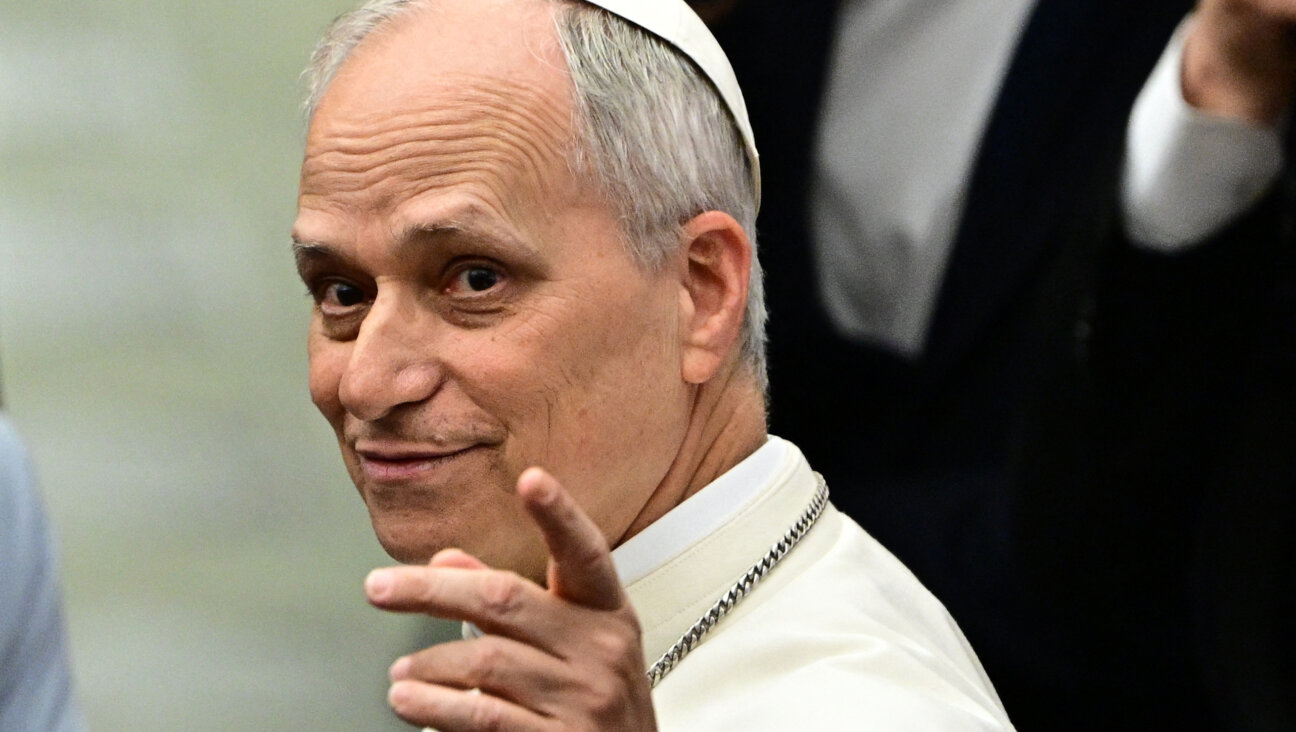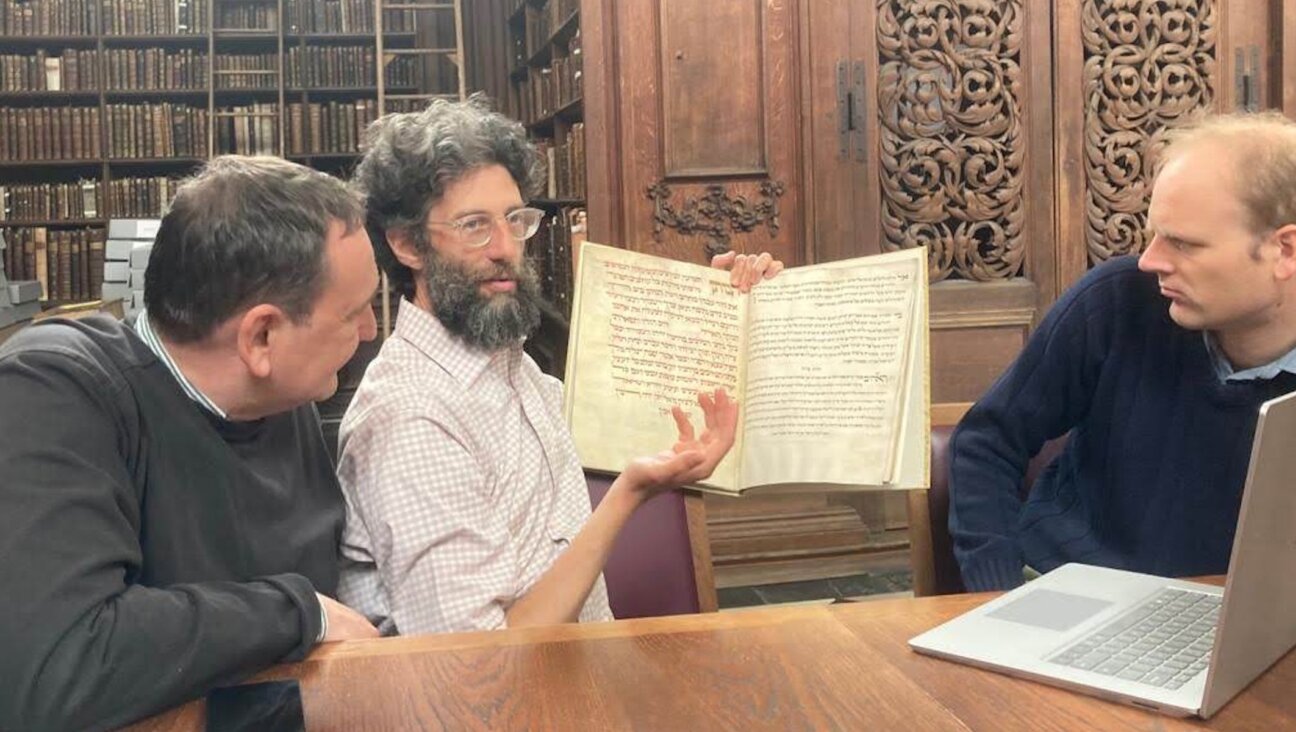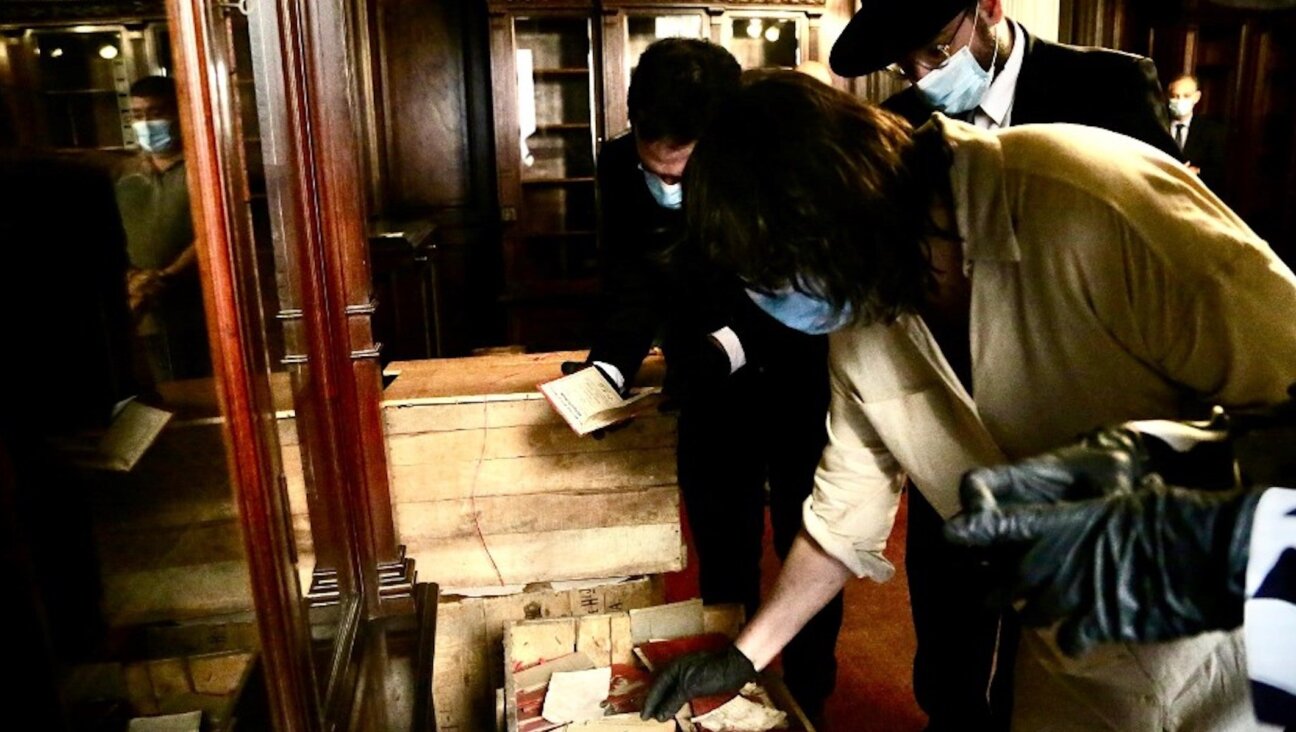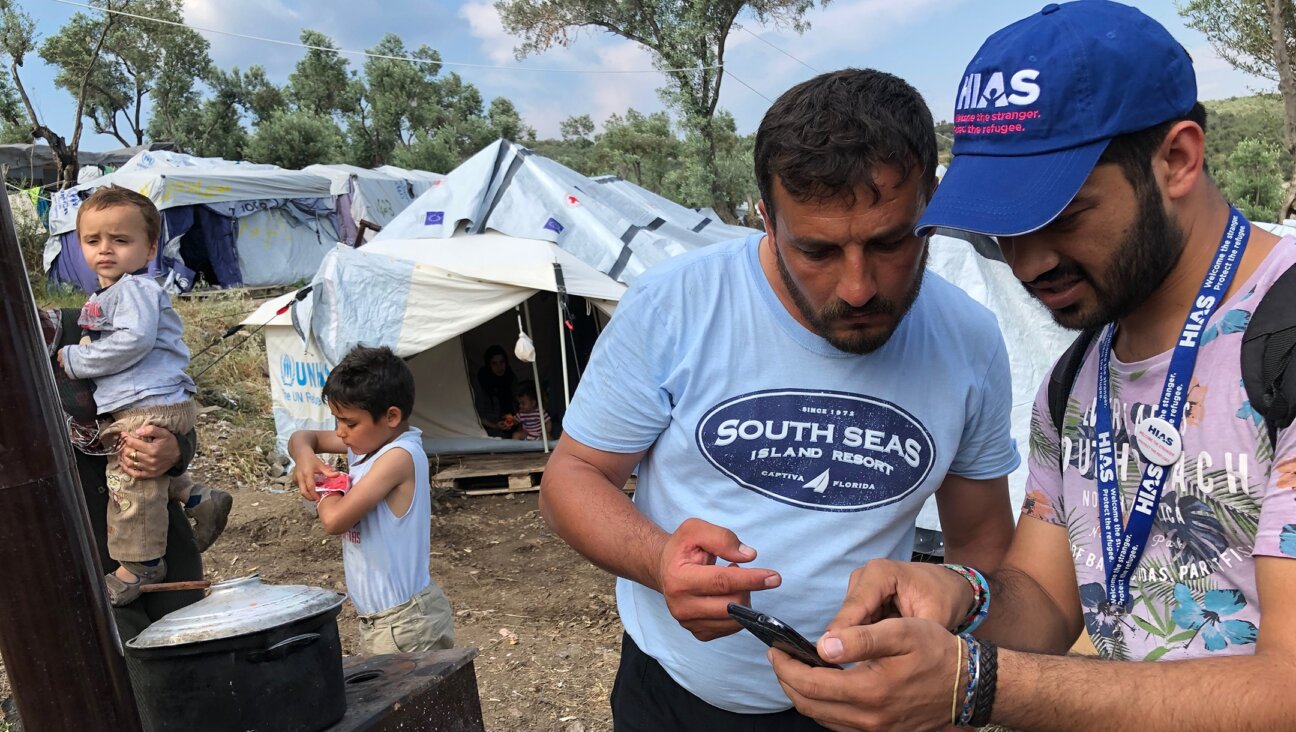They lost pregnancies or infants. Now, Israeli parents want access to burials that have long been secret

Malka, whose newborn twins died in 1979, visits their grave in the Har Hamenuchot cemetery in Jerusalem in 2021. After learning where the baby boy and girl had been buried, Malka placed a memorial stone on their joint grave. She later discovered that a burial society had built burial plots over the graves of hundreds of infants near where hers had been buried. She asked that her last name not be used to protect her family’s privacy. Photo by Michele Chabin
JERUSALEM – Ten years ago, Aliza and Netanel Fenichel and their young children were in a car accident. Aliza, who was 25 weeks pregnant and badly injured, underwent an emergency cesarean section to save her life, and her unborn son’s. The boy weighed about a pound and a half and died the same day.
“When I woke up in the middle of the night, it suddenly hit me: Where’s my baby?” Aliza said. “It was disturbing that we didn’t know what they’d done with his body.”
The Fenichels’ son had been buried according to the practice of many burial societies, known as Minhag Yerushalayim, or the Jerusalem custom. Dating from before modern Israel was founded, it forbids parents from participating in the burial of an infant who is miscarried or stillborn or who lives fewer than 31 days, or even knowing the location of the grave.
The Fenichels often thought about their lost son, whom the burial society named and circumcised. But they spent years recovering from the accident, and it wasn’t until 2018 that they decided to find out what had happened to their baby’s body. They were given directions to the section of Har Hamenuchot, the largest cemetery in Jerusalem, where a chevra kadisha, or burial society, said it had interred him.

Photo by Hu Chen
“The graves were just a bunch of dirt,” Aliza Fenichel said, recalling the shock and sadness of the discovery. “It wasn’t clear where one grave starts and ends, and there’s no way to figure it out. I wasn’t convinced that’s exactly where he was buried.”
The Fenichels’ experience is not uncommon in Israel, where a custom rooted in religious law and tradition is increasingly at odds with the way many parents wish to grieve a failed pregnancy or an infant who dies shortly after birth. More and more, parents want to hold and name these babies, and to mourn them at marked graves.
In Israel, the government covers the cost of the burial of every Israeli, regardless of their religion. But survivors must pay if they want their loved one buried in a way different from the burial societies’ norm, or in a different municipality.
Until a few years ago, Israeli burial societies — which handle most Jewish burials and usually operate under the auspices of Orthodox authorities — operated largely unregulated. But in recent years, a growing movement has pushed back against the religious establishment.
Since 2016, government guidelines have given parents the right to participate in such burials and to know where the graves are located. And a civil ceremony, as opposed to a religious one, is now an option.
But for many, little has changed. The revised rules have loopholes, and enforcement can be spotty. Some hospitals don’t inform parents of their options, and many of the country’s 562 burial societies – including 13 of the 14 in Jerusalem – still exclude them from burials. Advocates continue to push for more parental involvement, hoping that traditional mourning rituals will help the bereaved come to terms with their loss.
That’s what happened for the Fenichels, who put a small matzevah, or grave monument, on the burial site about a year ago. They posthumously named the baby Yitzhak Tam, and had it engraved on the stone.
“It was an important step that we took, part of our recovery,” Aliza Fenichel said. “It’s given me a place to mourn him. It’s given me more clarity and a feeling I was closer to him.”
Throughout Israel, parents are still searching for such graves. Some who have been able to locate them have been horrified to find unmarked plots, some of them containing remains from multiple corpses — and in at least one case, adult bodies placed on top of them.
The sages meant well …
In the eyes of the rabbis who codified Jewish mourning practices, a lost pregnancy or a baby who survives fewer than 31 days does not require burial and mourning rites. The time frame appears to be based on the laws of pidyon haben, the redemption of the firstborn son, which occurs when an infant is 31 days old. According to both Maimonides and the Shulchan Aruch, the most widely consulted code of Jewish law, such babies are not mourned, at least not through traditional Jewish mourning rituals.
In Hakirah, a peer-reviewed journal of Jewish law and thought, Rabbi Dr. Jason Weiner explained in 2018 that some scholars believed that such an infant or fetus is “pure,” so there is no need for rituals that “elevate” the soul. Others, he wrote, may have wanted to help parents recover from their loss as quickly as possible.
The idea is to prevent people from mourning excessively by observing more rituals than required, Weiner added, not “to minimize the terrible pain that the parents often experience.”
Get the Forward delivered to your inbox. Sign up here to receive our essential morning briefing of American Jewish news and conversation, the afternoon’s top headlines and best reads, and a weekly letter from our editor-in-chief.
Several Orthodox rabbis in Israel contacted by the Forward declined to discuss the Jerusalem custom on the record. But Rabbi Ephraim Pessin, director of the Chevra Kadisha of Rockland County north of New York City, said that the practice was also widespread for centuries in Eastern Europe.
The remains of failed pregnancies and infants who died soon after birth were buried in a neighboring village, he said, without the parents’ involvement or knowledge of the gravesite’s location. “The chevra kadisha would wash the baby’s body and if it was a boy and big enough, give him a bris.”
The practice remains common in Orthodox parts of the diaspora as well as in Israel. But Pessin said he knows that in many maternity wards, nurses now ask parents if they want to hold and spend some time with deceased infants.
“Frankly, this is the opposite of our approach, which is to not have parents dwell on their loss, but to instead pick themselves up and to continue to go on with their lives,” he said. “Of course, we understand that parents are grieving.”
In New York State, the next of kin have the right to know where their relative is buried, so the chevra kadisha must share that information if requested, Pessin added. “We cannot violate that law.”
Ziva Glanz, who lost an infant born at 24 weeks gestation and lobbied the Israeli government to change the Minhag Yerushalayim, said she believes “it started as a nice thing, when families couldn’t afford a burial plot, when there was rampant disease in Israel, rampant poverty, and babies and children died often.”

Ziva Glanz, a parent who lobbied to change Israeli rules governing burial after miscarriage, stillbirth or death shortly after birth. Courtesy of Ziva Glanz
But Israel’s burial societies need to change along with society, she argued. In Israel as in the U.S. hospital employees often encourage parents whose babies die to spend time with them.
“The burial societies cite this Minhag Yerushalayim as if it’s Jewish law, couched in religious terminology – it’s not a law,” Glanz said.
“They claim that keeping the details from parents helps them move on faster. But it doesn’t help,” she said, adding that parents who do not know where the grave sites are “get stuck in time. It wears them down. It affects their mental health.”
Navit’s endless search
Navit Popovich is one of those parents. In 2013, she terminated a pregnancy in the third trimester after learning that the fetus had a brain abnormality incompatible with life.
“We should have seen him and hugged him and told him we loved him,” Popvich said. “We thought it would be easier, but not long afterward we realized it was a big mistake.”
She wanted to find his grave – “a place where I can say ‘I’m sorry’ and go and talk to him,” she explained – and started by contacting the hospital where she had the termination procedure. That hospital referred the couple to a second hospital, which referred them to a Tel Aviv burial society.
An administrator at the society hemmed and hawed, Popovich said, and refused to release any information. She and her husband then called ITIM, an organization that helps Israelis navigate the religious establishment.
ITIM, working on the couple’s behalf, was told by the burial society that it had no documentation related to the family. Rabbi Seth Farber, the group’s founder, said it was still seeking information about the case.
“No one has the records,” Popovich said, her voice breaking. “I really hope they did bury him. It’s like he was never born, never a person.”
ITIM, which has also fought to loosen the ultra-Orthodox grip on kashrut, marriage and conversion in Israel, began trying to help bereaved parents in 2014. Its staff reached out to the burial societies, and discovered how difficult it is to find these graves, as well as what Farber described as their “horrendous condition.”

Rabbi Seth Farber, the founder of ITIM, an organization that helps Israelis navigate the religious establishment.
Under pressure from ITIM and other activists, a joint committee was formed — by the ministries of justice, health and religious affairs — that developed the 2016 changes to the way such burials are handled, as well as guidelines for all burial sites. Parents now have the right to know the sites’ location.
Graves on top of graves
But that has led to compounded grief for some, like a woman named Malka who spoke on the condition her last name not be used to protect her family’s privacy.
Malka had twins who died within days of their birth in 1979. She did not speak about them, even to relatives, until her oldest living son’s bar mitzvah.
And it took about 20 more years until she was ready to find their burial site at Har Hamenuchot. Like the Fenichels, she was stunned to discover that the joint plot was in a section of about 40 rows of bare concrete slabs, with no separation between the unmarked graves. “I was ashamed that my babies were buried like that, and I never took my parents there,” she said during an emotional visit to the cemetery.
Malka and her family eventually placed a small flat stone at the site. A few years later, she started lighting two extra Shabbat candles every week to represent the lost twins.
But during a visit to the cemetery in 2012, Malka discovered that more than 20 rows of infant graves had been covered over with another level of graves. She said her family and the others – including those that purchased the second layer of plots – were not informed.
“Hundreds of babies are just covered up, with adults buried on top of them!” Malka said, gazing at the raised section. “This is a scandal.”

For decades, burial societies at the Har Hamenuchot cemetery in Jerusalem have interred infants who died in the womb or within 30 days of their birth in unmarked rows of graves covered by bare concrete. About a decade ago, a burial society covered about 20 rows of infant graves with another level of graves, shown in this 2021 photo, without informing either the babies’ parents. Photo by Michele Chabin
A spokesman for the Ministry of Religious Affairs said that the Kehillat Yerushalayim burial society, which built the second level of graves, did so without a permit and without the ministry’s knowledge. He said the ministry is working to prevent similar situations by increasing its supervision over the burial societies.
Asked about the double-decker graves, Kehillat Yerushalayim said in an email that it operates within “the laws and customs of Jerusalem and in accordance with the various regulatory guidelines, including the Ministry of Health and the Ministry of Religions.”
Regarding the Jerusalem custom more generally, the society said that parents whose babies died within a month of birth “can say an intimate goodbye at the funeral home.” For those who want to know the place of burial, the email continued, “a representative of the burial society accompanies them personally to the place, and they can set up a memorial plaque with an inscription as they see fit.”
When Malka discovered the double-decker graves, no one had been buried above her twins. After her family brought “before” and “after” photos of the site to the burial society, and insisted that it restore her children’s grave, the society agreed to pay for a large adult-size gravestone, she said, with the babies’ names and dates of birth and death.
A new way to mourn
Each Friday, a few hours before blessing his living children during Shabbat dinner, Daniel Glanz visits Har Haminuchot to bless his son Malachi.
Born in 2015 at less than 24 weeks gestation, Malachi died within hours. Glanz said that the hospital handed him and his wife, Ziva, a form to agree to a burial without parental involvement, but that they never saw the Ministry of Health form they were supposed to have received, outlining the option of a private burial they could attend.
Still, the couple insisted on being present.
“Obviously it’s very hard to watch your child being buried,” Ziva Glanz said. “But there is beauty in grief. By putting one foot in front of the other, whatever way we can during early stages of grief, we’re building emotional muscles for ourselves.”
Now, Ziva Glanz runs the Israeli division of Our Tapestry, an international support group for bereaved Jewish mothers. She sees the full traditional mourning rituals of Judaism as therapeutic, and says that many Israeli burial societies are robbing parents of their right to participate in the burial.
“Halacha is beautifully designed to move through this process,” she said. “But all too often, parents mistakenly believe that the practices of the chevrei kadisha are the philosophy of Judaism.”
Today, Glanz said, some parents are going beyond the halacha. They are sitting shiva — the intense week of mourning — for lost infants and others even though it is not required according to Jewish law.
“Jews aren’t obligated to sit shiva for stepchildren, for instance. However, they can choose to sit shiva if they want to,” she explained. “The problem isn’t with halacha, it’s with people.”
The Glanzes have placed a matzevah on Malachi’s gravesite.
It “has become my holy place, where I have my greatest spiritual connection,” Ziva Glanz said. “It’s my place of comfort, where heaven and earth connect.”
The Forward is free to read, but it isn’t free to produce

I hope you appreciated this article. Before you go, I’d like to ask you to please support the Forward.
Now more than ever, American Jews need independent news they can trust, with reporting driven by truth, not ideology. We serve you, not any ideological agenda.
At a time when other newsrooms are closing or cutting back, the Forward has removed its paywall and invested additional resources to report on the ground from Israel and around the U.S. on the impact of the war, rising antisemitism and polarized discourse.
This is a great time to support independent Jewish journalism you rely on. Make a gift today!
— Rachel Fishman Feddersen, Publisher and CEO
Support our mission to tell the Jewish story fully and fairly.
Most Popular
- 1

Fast Forward Ye debuts ‘Heil Hitler’ music video that includes a sample of a Hitler speech
- 2

Opinion It looks like Israel totally underestimated Trump
- 3

Culture Is Pope Leo Jewish? Ask his distant cousins — like me
- 4

Fast Forward Student suspended for ‘F— the Jews’ video defends himself on antisemitic podcast
In Case You Missed It
-

Fast Forward For the first time since Henry VIII created the role, a Jew will helm Hebrew studies at Cambridge
-

Fast Forward Argentine Supreme Court discovers over 80 boxes of forgotten Nazi documents
-

News In Edan Alexander’s hometown in New Jersey, months of fear and anguish give way to joy and relief
-

Fast Forward What’s next for suspended student who posted ‘F— the Jews’ video? An alt-right media tour
-
Shop the Forward Store
100% of profits support our journalism
Republish This Story
Please read before republishing
We’re happy to make this story available to republish for free, unless it originated with JTA, Haaretz or another publication (as indicated on the article) and as long as you follow our guidelines.
You must comply with the following:
- Credit the Forward
- Retain our pixel
- Preserve our canonical link in Google search
- Add a noindex tag in Google search
See our full guidelines for more information, and this guide for detail about canonical URLs.
To republish, copy the HTML by clicking on the yellow button to the right; it includes our tracking pixel, all paragraph styles and hyperlinks, the author byline and credit to the Forward. It does not include images; to avoid copyright violations, you must add them manually, following our guidelines. Please email us at [email protected], subject line “republish,” with any questions or to let us know what stories you’re picking up.















